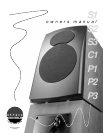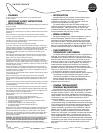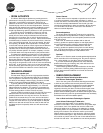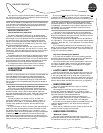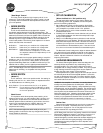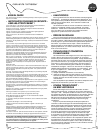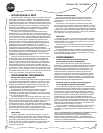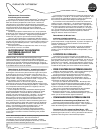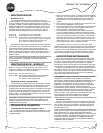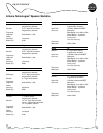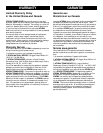
owners manual
3
• ROOM ACOUSTICS
The Athena Technologies
®
speakers can provide great sonic
performance in virtually any environment if proper placement is
respected in a good listening environment. Factors such as
placement of furniture, room dimensions, and wall construction
materials all play roles in the final sound reproduction. Therefore,
both acoustic and aesthetic factors must be considered, but since
aesthetics are personal and vary greatly, some basic guidelines
should help determining optimum placement for sonic performance.
The music we hear is a combination of direct (on axis) and
reflected (off axis) sound. The direct sound arrives at your ears
directly from the source while the reflected sound arrives after
bouncing off room surfaces. The on and off axis performance is
affected by the various surfaces in the room. Various surfaces reflect
sound differently so a balance of soft and hard furniture, as well as
floor or wall hangings are ideal. Too much soft material, like sofas
and carpeting, can deaden sound reproduction. Conversely, hard
furniture and floors can produce a harsh, brighter sound. Reflective
surfaces have individual sound absorption characteristics so it is
important that the left and right reflective walls have the same, or
very similar, reflective qualities. For example, a tapestry or curtain
on wall will absorb more frequencies than a plain painted surface.
The distance the speakers are placed from room boundaries can
affect the amount of bass. Placement closer to corners generates
more bass output, farther away from corners will generate less bass.
Rooms with different height, width and length are preferable for
best bass performance. If possible, place the speakers so they are
firing along the longest wall in order to fill the room most efficiently
with music. In other words, if the room is 10-feet (3m) wide and
20-feet (6m) deep, place them along the 10-foot (3m) wall. There
will be less wall reflection and therefore a more natural sound.
• SPEAKER PLACEMENT
Stereo front speaker pair
For best stereo imaging, the left and right speakers should be
the same distance from their respective side walls. If the distance
from one speaker to the listener is very different from the other it
can affect the soundstage or stereo imaging. Therefore, the ideal
position is having the speakers equidistant to the listener.
A general guideline for speaker placement is to set up the space
between speaker and listener at approximately 1-1/2 times the
distance between the speakers. For example, if the speakers are
placed a minimum of 6-feet (1.8m) apart (the absolute minimum),
the best seating position would be 9-feet (2.4m) away.
Another guideline is referred to as the rule of thirds. This formula
dictates that the room should be divided into thirds, with the
speakers placed a third of the way into the room. The listener is
positioned in the second third of the room, with the last third of
the room behind the listener. This may be impractical or difficult to
integrate into some decors, so try to at least respect an adequate
distance from side and rear walls. Do not make the side and rear
wall distances (from the speaker) similar as it will cause acoustic
problems.
Center Channel
A center channel can be expected to reproduce as much as 60%
of a movie's soundtrack, most of which is dialogue. In order to
maintain the effect of voices emanating from the actor's mouth, the
C1 should be centrally located between the left and right main
channels and placed above or below the television. Be sure that the
C1's front baffle is flush with the front face of the television or
cabinet to maximize dispersion.
Surround speakers
The chosen Athena Technologies
®
products to be used as the
surround speakers can be positioned in a variety of locations. The
most popular places used for surround speaker placement are side
wall, and rear wall.
Side walls: To maximize the ambient field for side wall
mounting, position the speakers adjacent to and slightly behind
the primary listening area at a height of approximately 6 feet.
Rear walls: To maximize the ambient field for rear wall
mounting, position the speakers so they flank the main listening
area. They should be raised to a height of approximately 6 feet
and should ideally have a space of 6 feet between them.
Optional
Stand mount: Place the stand mounted speakers slightly behind
and on each side of the main listening area. They can be anywhere
from 1-6 feet behind or to the side of the main listening area.
If you have followed these guidelines, then there should be
speakers surrounding your listening area, which will result in the
encompassing surround sound feeling.
These are basic guidelines and can be tailored to suit the décor
of your room. Following these guidelines will help to provide a
sense of spaciousness and ambience for all music and surround
sound formats.
• SUBWOOFER PLACEMENT
Using the Athena Technologies Subwoofers
with Athena Technologies
®
speakers
One of the main goals of the Athena Technologies
®
series was
to eliminate the problems that commonly arise with subwoofer
placement. The large, bulky box appearance normally associated
with subwoofers is difficult to integrate into a room without
negatively influencing the décor. The Athena Technologies
®
series
subwoofers were designed in a slim, upright fashion to serve as a
speaker stand and docking base for the Athena Technologies
®
series
speakers, transforming them into powered speakers that acoustically
blend better than subwoofer satellite systems.
How to Dock an Athena Technologies
®
Speaker
to an Athena Technologies
®
Subwoofer
Determine the ideal location for the speakers. Place the
subwoofer in this location. Then, remove the two long rubber strips
on the bottom, front of the speaker that cover the metal tracks.
Remove the plastic cover on the top of the subwoofer, to expose
the docking tracks. Lift up the speaker to the subwoofer's height,
starting from the back of the subwoofer and line up the tracks.
Slide the speaker forward on to the subwoofer, ensuring that both
tracks are connected together. Stop movement when the speaker
will not slide any further forward. The rear of both cabinets should
be flush with each other. Your speakers are now securely attached.



